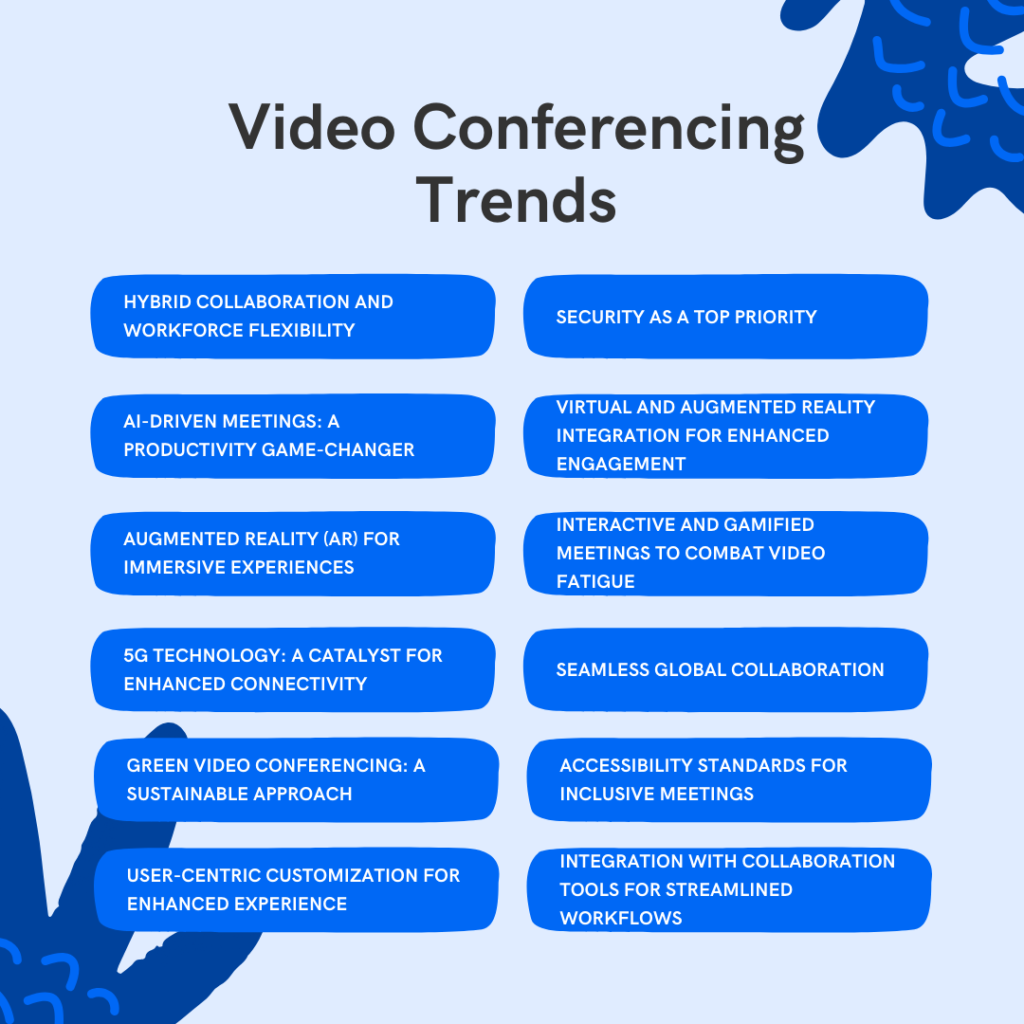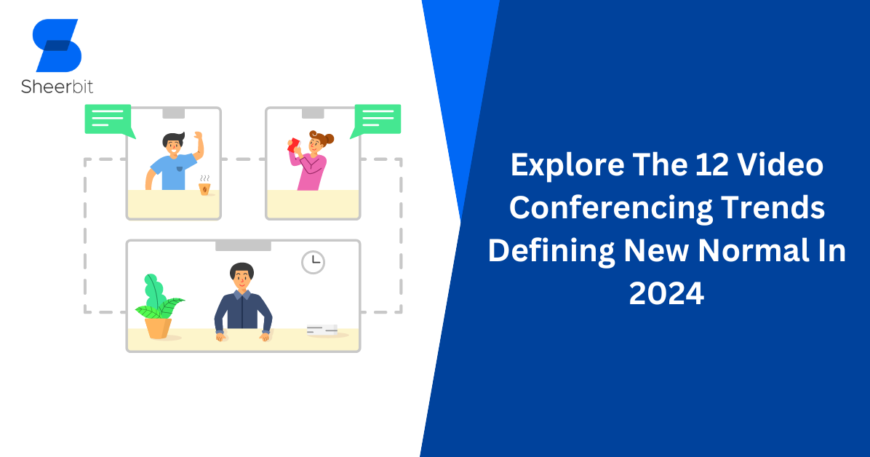Video conferencing is a key component in the constantly changing field of communication technology, playing a vital role in facilitating the fluid dynamics of contemporary connectedness. The importance of video conferencing is becoming more apparent than ever as we approach the year 2024. It’s become an inseparable part of both our work and home life, serving as a bridge for cooperation when faced with a variety of chances and obstacles. Amid a global trend towards hybrid work patterns and a growing dependence on distant communication, video conferencing trends play a function that goes beyond comfort to become a vital tool for both individuals and enterprises.
Together, we will examine all 12 of the key developments in video conferencing trends, which have the potential to completely transform the way we interact, work, and communicate in the upcoming months. A collaborative drive towards a more immersive, efficient, and sustainable digital future is reflected in these themes, which range from the inclusion of augmented reality to the integration of artificial intelligence. Our approach to virtual collaboration is evolving along with technology, and it is becoming more and more important to have an awareness of these trends to be flexible in a constantly shifting environment.

1. Hybrid Collaboration and Workforce Flexibility
The increasing popularity of remote work is drastically changing the nature of the workplace. By 2024, we see a transition in the paradigm towards hybrid collaboration—where face-to-face and virtual interactions coexist together. Growing employee need for flexibility is driving this trend. Recent surveys have indicated that 68% of employees exhibit a desire for a mixed work style. This highlights the necessity for video conferencing solutions that can connect physical and virtual collaborative spaces.
2. AI-driven Meetings: A Productivity Game-Changer
AI is starting to show up in video conferences, turning gatherings into smart and productive exchanges. Up to 20% of meeting time is predicted to be saved by organizations using AI-driven features like agenda planning, automated meeting scheduling, and intelligent meeting summaries. Further improving cross-cultural communication and increasing the effectiveness and inclusivity of virtual meetings are real-time language translation and sentiment analysis technologies.
3. Augmented Reality (AR) for Immersive Experiences
The integration of augmented reality with video conferencing trends will change the way teams communicate with one another. AR will provide immersive and engaging meeting spaces in 2024, surpassing the capabilities of virtual backdrops. Imagine online brainstorming sessions and cooperative 3D presentations where participants may move things in real-time. This tendency not only increases participation but also cultivates a more imaginative and lively environment for cooperation.
4. 5G Technology: A Catalyst for Enhanced Connectivity
Video conferencing will never be the same when 5G is widely used. A smooth and excellent video experience is what consumers can anticipate with quicker and more dependable internet access. This is especially important for multinational teams and distant workers who depend on video conferencing for efficient communication. The quality and dependability of video conversations are predicted to rise by 30% when 5G becomes widely used.
5. Green Video Conferencing: A Sustainable Approach
Video conferencing systems are actively trying to lessen their environmental effect as sustainability becomes a major concern for many organizations. Green virtual conference room designs, renewable energy-powered server farms, and energy-efficient algorithms are becoming commonplace. There has been a 25% decrease in the carbon footprint of video conferencing as a result of businesses taking an increased interest in the environmental impact of their communication technologies.
6. User-centric customization for Enhanced Experience
Systems for video conferences are using configurable user interfaces as a means of acknowledging the importance of the user experience. Users can choose interface colors, backdrops, and layouts in their virtual meeting places. The objective of this user-centric approach is to enhance overall happiness and provide a more cozy and customized collaboration setting.
7. Security as a Top Priority
Concerns about security and privacy have gained prominence as a result of the rise in remote employment. Platforms for video conferences are making significant investments in multi-factor authentication, improved encryption, and safe data transfer methods. Anticipate a 40% surge in security-oriented functionalities by 2024, guaranteeing the confidentiality and protection of critical data exchanged in virtual meetings.
8. Virtual and Augmented Reality Integration for Enhanced Engagement
The virtual meeting environment is changing as a result of the confluence of augmented and virtual reality. Participant holographic representations, interactive 3D presentations, and virtual collaborative whiteboards are starting to become commonplace. By bridging the gap between in-person and virtual engagements, this integration makes meetings more immersive and dynamic, which increases engagement.
9. Interactive and Gamified Meetings to Combat Video Fatigue
Platforms are adding gamified and interactive features to keep users interested as video conference weariness spreads. These elements offer a fun and varied element to professional encounters, ranging from interactive polls and quizzes to virtual team-building exercises. Research suggests that the inclusion of interactive aspects in meetings leads to a 20% boost in participant satisfaction.
10. Seamless Global Collaboration
Geographical barriers are being removed through video conferencing, allowing for seamless global cooperation. These days, common features include worldwide compatibility, real-time language translation, and cultural sensitivity tools. This trend promotes a more inclusive and connected work environment by facilitating better communication across varied, international teams.
11. Accessibility Standards for Inclusive Meetings
Platforms for video conferences are changing to adhere to stricter accessibility guidelines. In order to ensure that virtual meetings are inclusive and accessible to individuals with disabilities, several accessibility elements such as screen reader compatibility and real-time captioning are being included. This dedication to accessibility is consistent with the values of inclusion and diversity, which promote fairness in the workplace.
12. Integration with Collaboration Tools for Streamlined Workflows
Video conferencing solutions concentrate on smooth interaction with other collaboration tools to offer a complete collaboration experience. Integration with document-sharing services, virtual whiteboards, and project management software results in improved workflow efficiency and productivity overall. This pattern shows a move towards integrating different communication and collaboration technologies into cohesive workplaces.
In summary, 2024 seems to be a critical year for video conferencing trends, since these developments will influence how people collaborate virtually in the future. Businesses may remain ahead of the curve and contribute to the development of a more connected, effective, and sustainable digital workspace by embracing these innovations.
Ready to revolutionize your virtual collaboration experience? Discover the cutting-edge capabilities of SheerBit’s video conferencing system right now. Using cutting-edge technology and seamless connectivity, elevate your meetings.





